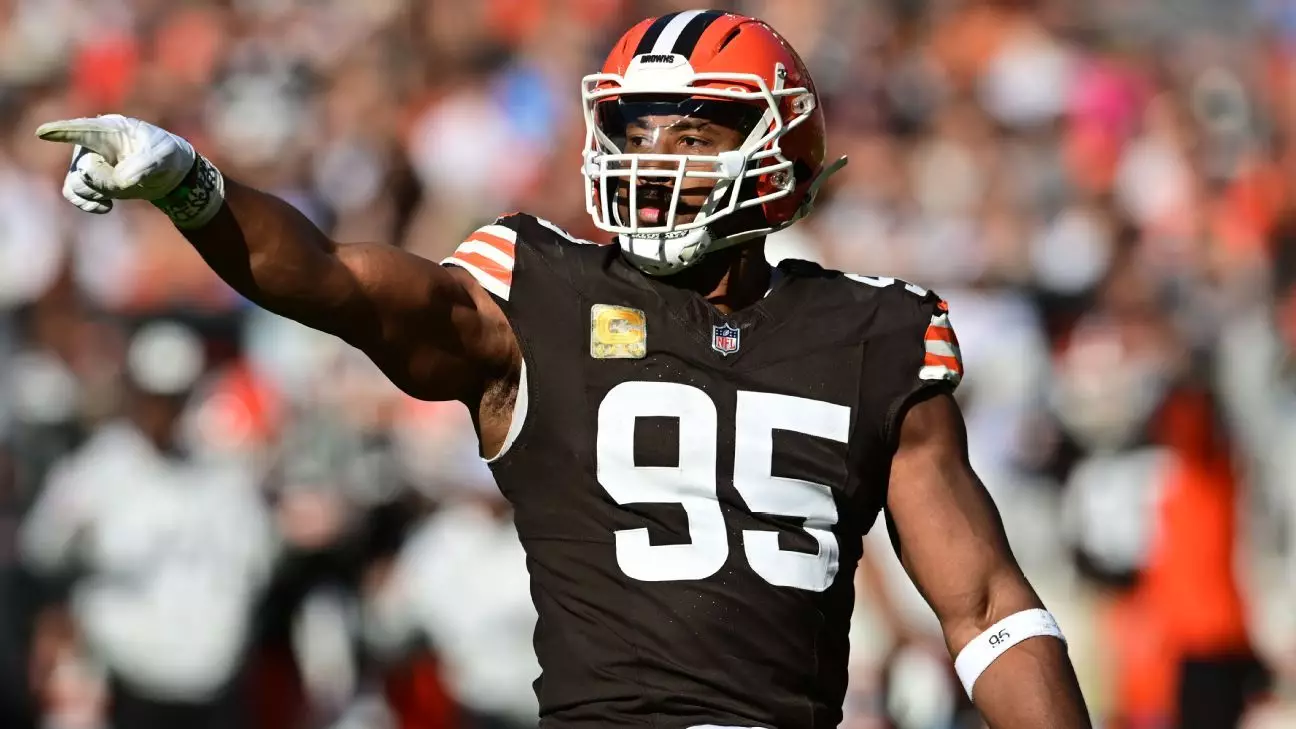In a shocking revelation that has sent ripples throughout the NFL, Myles Garrett, the Cleveland Browns’ star defensive end and reigning Defensive Player of the Year, publicly announced his desire to leave the franchise. His statement is not only a reflection of personal aspirations but also a stark indictment of the franchise’s struggles, particularly following a disappointing 3-14 season. Garrett, who has been one of the few bright spots for the Browns since being drafted first overall in 2017, articulated a deep yearning for competitiveness and the opportunity to pursue a Super Bowl – a dream seemingly at odds with Cleveland’s recent performance.
Garrett’s statements came as no surprise to observers who have closely followed the dynamics between star players and struggling franchises. His frustrations have been amplified by a series of losing seasons, marking six unsuccessful campaigns for the defensive end. His ambition and drive to succeed may not only fuel his own career but also illustrate a broader concern among elite athletes: the desire for success in an era where mediocrity can become tolerable for franchises.
Garrett remains under contract for two more years on a lucrative five-year, $125 million extension that he signed in 2020. However, the absence of guaranteed salary moving forward presents a unique dilemma. While financial security for players is fundamental, the importance of winning is paramount for elite athletes such as Garrett. This tension between financial commitment and competitive success is a driving force behind his trade request. The Browns hold the second overall pick in the upcoming NFL draft, which signals a potential rebuilding phase, something Garrett expressed a reluctance to endure once more.
The implications of such a move from Garrett are multi-faceted. His trade request puts pressure not only on the Browns’ management, specifically GM Andrew Berry, but also on the coaching staff and the future direction of the team. The organization must now consider the opinions of its star player, who has shown loyalty in the past but finds himself at a crossroads where personal ambition and team dynamics are increasingly at odds.
Berry’s heartening remarks about his aspirations for Garrett to retire as a Brown suggest a willingness to invest in negotiating a future that avoids fracture. Berry’s firm stance on non-trading Garrett underscores the franchise’s commitment to retaining its most valuable asset, though this steadfastness may also be perceived as a gamble. The question arises: can the Browns orchestrate effective changes to their roster and strategy to align with Garrett’s hopes for competitiveness?
The narrative encapsulated in Garrett’s request highlights a deeper crisis in the organization, one that necessitates a reevaluation of how the franchise revolves around player satisfaction, effective management, and strategic planning. Should the Browns fail to enhance their roster adequately or present a compelling vision that resonates with Garrett, the stakes will only escalate, possibly catalyzing further unrest among other talent if perceptions of incompetency persist.
Cleveland’s fanbase, weary from years of disappointment, is torn. Many share Garrett’s frustration with the team’s slow evolution and lack of sustained success, while others are passionately defensive of the organization’s legacy and stability. The question of whether the franchise can pivot effectively in response to Garrett’s demands is as much a commentary on fan expectations as it is on player aspirations.
The insights gathered from this situation beg further reflection on the relationship between players and franchises in the modern NFL. Myles Garrett’s cautionary stance underscores the seriousness with which elite athletes consider their legacies, victories, and overall trajectories amidst the hustle and turmoil of professional sports. As a result, how the Browns navigate this critical juncture could either salvage an era of potential or commence another phase of uncertainty.
Myles Garrett’s trade request transcends mere personnel shifts; it embodies the urgent complexities of competitive sports, athlete agency, and franchise dynamics. The coming weeks and months will reveal whether Garrett’s call for change resonates within the Cleveland community and is catalyzed by a turning point in the Browns’ history.


Leave a Reply